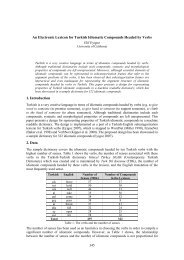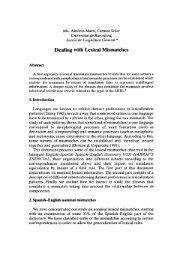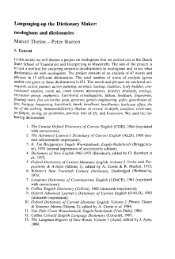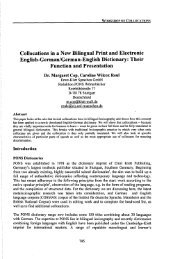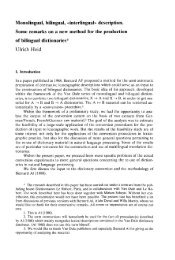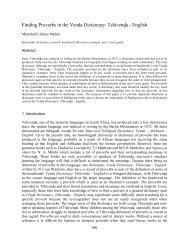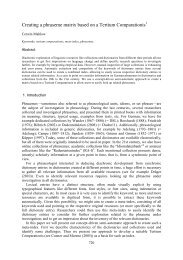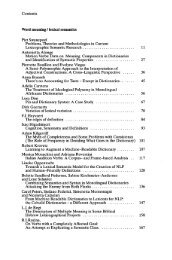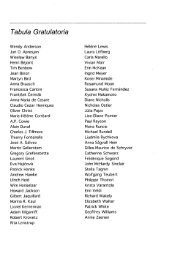Lexicon Creator: A Tool for Building Lexicons for Proofing ... - Euralex
Lexicon Creator: A Tool for Building Lexicons for Proofing ... - Euralex
Lexicon Creator: A Tool for Building Lexicons for Proofing ... - Euralex
Create successful ePaper yourself
Turn your PDF publications into a flip-book with our unique Google optimized e-Paper software.
T. Fontenelle, N. Cipollone, M. Daniels, I. Johnson<br />
The string Bond can correspond to the proper noun (James) Bond; the approximately equal sign<br />
indicates that Bond has an extended actual analysis (normalization) which is in the lexicon (both<br />
as a verb entry and as a regular noun entry).<br />
Annotating lexical entries<br />
The main purpose of <strong>Lexicon</strong> <strong>Creator</strong> is to be able to associate a lemma to all its valid inflected<br />
<strong>for</strong>ms, using the concept of template or morphological classes. It is possible to enrich the lexical<br />
data, however, by annotating lexical entries or their inflected <strong>for</strong>ms with linguistic attributes. In<br />
addition to part of speech in<strong>for</strong>mation, the data can be annotated with in<strong>for</strong>mation that can be<br />
consumed by applications such as spell-checkers, thesauri, morphological analyzers,<br />
handwriting recognizers, viz:<br />
- Dialect/regional distinctions (e.g. US vs. UK vs. Canadian vs. Australian English…; old<br />
vs. new spelling <strong>for</strong> languages that have undergone a spelling re<strong>for</strong>m, like French,<br />
German or Dutch; such in<strong>for</strong>mation is crucial to ensure that the re<strong>for</strong>m settings selected<br />
by the user of Microsoft Office spellers, if any, produce the desired results, as is shown<br />
in Fontenelle 2006)<br />
- frequency in<strong>for</strong>mation<br />
- levels of <strong>for</strong>mality (offensive words may undergo a special treatment in a speller)<br />
- linking spelling variants (<strong>for</strong> query expansion in search engines, which need to know<br />
that a <strong>for</strong>m like produkt in Dutch is the old spelling of what should now be written<br />
product after the 2005 spelling re<strong>for</strong>m; similarly, the French words ile and île can be<br />
linked as spelling variants <strong>for</strong> search technologies)<br />
- compound segmentation (<strong>for</strong> compounding languages, knowing where a lexicalized<br />
compound should be segmented is crucial in order <strong>for</strong> a word-breaker to be able to emit<br />
the correct segments in a search and indexing perspective)<br />
- synonyms (<strong>for</strong> thesauri)<br />
- number, person, tense, gender, transitivity in<strong>for</strong>mation, etc.<br />
Any type of linguistic in<strong>for</strong>mation that can be useful <strong>for</strong> NLP, including text mining or<br />
classification schemes, can be added via flexible annotation schemas.<br />
Depending upon the type of application the linguist is developing, she will have to create an<br />
annotation schema which defines the additional types of in<strong>for</strong>mation (annotations) she would<br />
like to be able to use. Once an annotation schema has been defined with the Annotation Schema<br />
Editor, she can then load the schema, associate it with a lexicon and start annotating the data,<br />
which means that sets of attribute-value pairs can be attached to lexicon objects. A schema<br />
associated with a lexicon is embedded as a resource inside a template lexicon. Schemas can be<br />
modified and upgraded (<strong>for</strong> instance when a given application requires a new type of linguistic<br />
in<strong>for</strong>mation, which needs to be added to an existing schema).<br />
Any kind of lexicon object can be annotated: template classes or templates, lemmas (lexical<br />
entries), individual inflected <strong>for</strong>ms, or even slots corresponding to inflected <strong>for</strong>ms associated<br />
with a given part of speech (e.g. one might decide to annotate all inflected <strong>for</strong>ms corresponding<br />
to a Past Subjunctive in French as Frequency=Low, <strong>for</strong> instance). Because annotations can be<br />
assigned at various levels, it has been necessary to develop a system of “cascading annotations”.<br />
This system interprets annotations by assigning a total order on objects in the lexicon and<br />
defining rules <strong>for</strong> annotation overriding and inheritance. Annotations “cascade” from a higher<br />
lexicon object to a lower one and lower values on the cascade override higher values. For<br />
instance, a noun inflection might have Restricted=Archaic set at the template class slot level,<br />
with that inflection set to Restricted=None at the (lower) inflected <strong>for</strong>m level of a few words<br />
where the inflection is still commonly used.<br />
In the example below, which illustrates the cascading annotations of the French plural word <strong>for</strong>m<br />
iles, one can see that the annotation Number=Plur is inherited from a Slot called Plur (the value<br />
364


